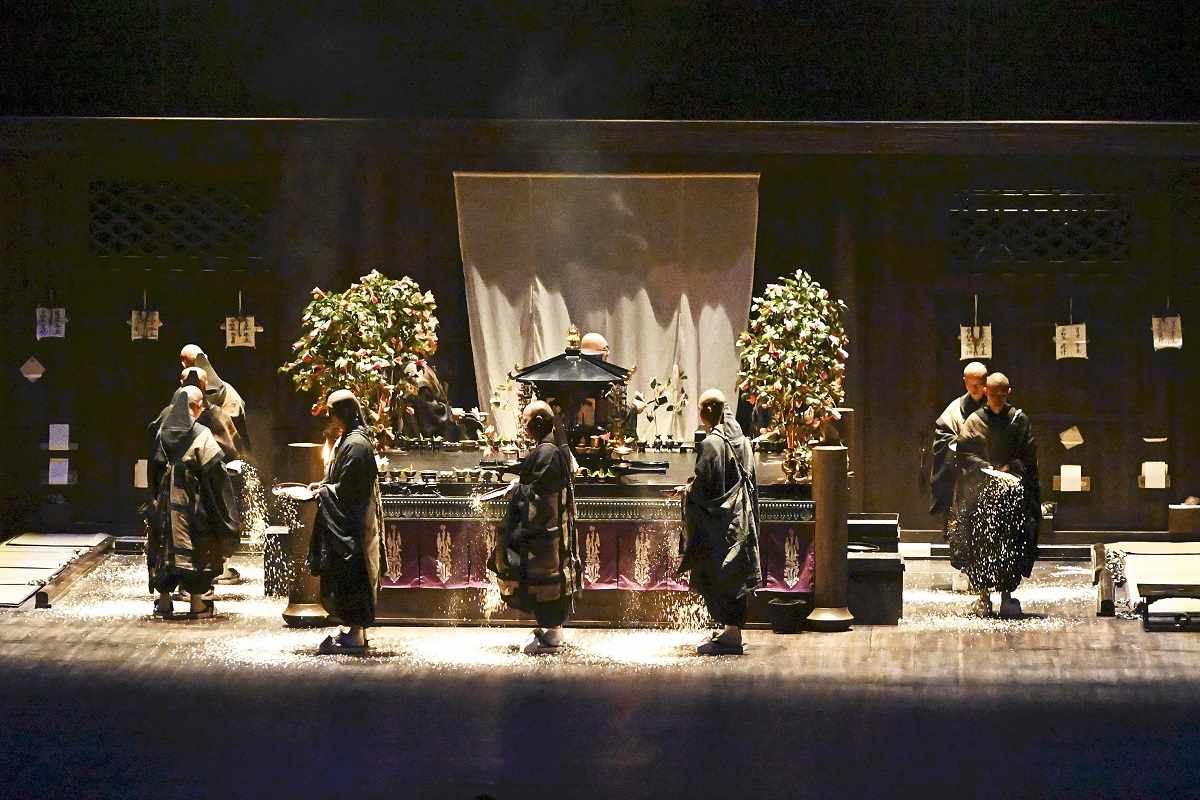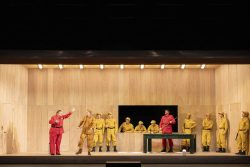
A scene from “Orochi” during Iwami Kagura by the Kameyama Shachu group in Suita, Osaka Prefecture, on May 7
11:00 JST, June 29, 2023
Kagura, dancing to live music to worship Shinto deities, and shomyo, the chanting of Buddhist sutras, are gaining attention as a result of live performances that are being held in different cities nationwide.
The organizers of these events expect these religious rituals to become widely known as local cultural traditions and revitalize different regions. They also hope to promote cultural traditions with the return of foreign visitors after the lifting of COVID-19 travel restrictions.
In kagura, dancers wear colorful costumes and perform depictions of mythological folklore to elegant flute playing and drumming. The stories are handed down over generations in various areas and there are said to be over 600 kagura groups throughout the country.
Kameyama Shachu, a kagura group from Hamada, Shimane Prefecture, performed at May Theater in Suita, Osaka Prefecture, last month, their first time performing in the prefecture. They danced Iwami Kagura from the prefecture’s Iwami area in a performance accentuated with smoke and confetti. The program included “Orochi,” which depicts the extermination of a giant snake. When the giant snake coiled on the stage, the audience applauded.
The event was organized by Ikuo Takahashi, 71, who operates a live music club in Osaka Prefecture. Several years ago, Takahashi became fascinated by the group’s gorgeous costumes and performing style with a modern interpretation of kagura.
“This is a wonderful art form that draws us into the world of ancient times. It’s a shame if people don’t to know about this,” Takahashi said. “I believe it is enjoyable for visitors from overseas and will even encourage them to visit the Iwami area.”
In Hiroshima and Shimane prefectures, where many kagura groups are active, such performances have been shown at not only shrines but local halls.
According to officials of the city of Akitakata, Hiroshima Prefecture, local kagura groups established an association about 10 years ago to start performing outside the prefecture in order to promote local tourism and attract new fans in the face of a decreasing number of performers due to population aging and decline.
The city government and others began holding kagura performances in Tokyo, before having their first one in the Kansai region last year.
On May 13 of this year, Hiroshima Kagura was performed at Mielparque Hall in Osaka. “I hope that [performing kagura outside the prefecture] will contribute to attracting new residents to the area and lead to more people performing and passing the traditions down to future generations,” said the chief of the city’s commerce, industry and tourism section.

The Shunie shomyo performed by Todaiji temple monks at the Festival Hall on May 13
Shomyo has been performed in halls at times since gaining attention as a form of Buddhist music in around 1980. The Hieizan Enryakuji temple in Otsu held a performance at the National Theatre in Tokyo in February this year.
On May 13, Todaiji temple in Nara gave a shomyo performance at the Festival Hall in Osaka. Shomyo has been a part of the temple’s sacred Shunie ceremony, or Omizutori, which has been held at Nigatsudo Hall since the Nara period (710-784). It was the first time shomyo was performed outside the temple in 14 years to mark the 1,250th anniversary of the death of the first head monk, Roben, who is also called Ryoben. Eleven monks performed on a stage decorated with a reproduced interior of Nigatsudo Hall.
“Shomyo is distinct like opera. It differs from Western vocalization because it uses the natural voice,” said the representative of the foundation that organized the event.
“Shomyo contains prayer that I hope will help people overcome what is currently going on in the world, such as the pandemic and the invasion of Ukraine,” said Koei Hashimura, the temple’s head monk.
Kenta Yamamoto, a professor specializing in economic geography at Kokugakuin University, explained the recent series of kagura and shomyo performances, saying, “Many people seem to be more interested in traditional Japanese culture. People overseas are also interested. I think [the performances] will be accepted in various ways as part of traditional Japanese culture.”
"Culture" POPULAR ARTICLE
-

Van Cleef & Arpels Dazzles with Art Deco Artisanry at Tokyo Exhibit
-

Disney’s ‘Twisted-Wonderland’ Animated Series Puts Villains in Spotlight: New Show Features School Inspired by Classic Disney Films
-

Japan Plans to Distribute Manga Overseas Via New Platform
-

Japanese Craftsman Produces Beautiful and Durable Bags Made of Wood
-

Ayumi Hamasaki’s Shanghai Concert Canceled Day Before Schedule as Part of Beijing Backlash
JN ACCESS RANKING
-

Keidanren Chairman Yoshinobu Tsutsui Visits Kashiwazaki-Kariwa Nuclear Power Plant; Inspects New Emergency Safety System
-

Imports of Rare Earths from China Facing Delays, May Be Caused by Deterioration of Japan-China Relations
-

University of Tokyo Professor Discusses Japanese Economic Security in Interview Ahead of Forum
-

Japan Pulls out of Vietnam Nuclear Project, Complicating Hanoi’s Power Plans
-

Govt Aims to Expand NISA Program Lineup, Abolish Age Restriction


_0001-250x189.jpg)
























